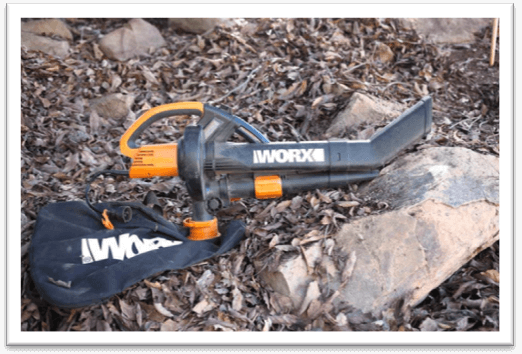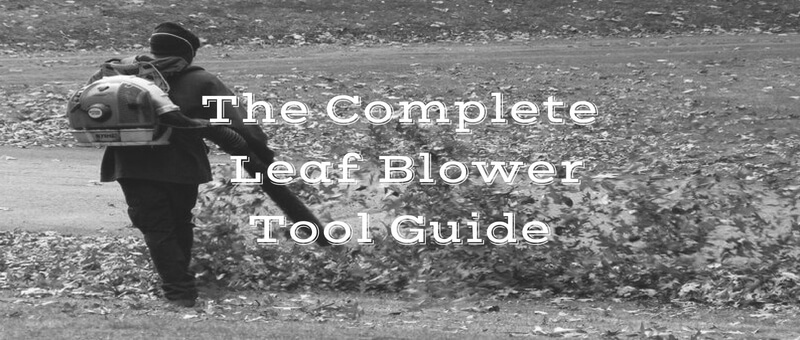Leaf Blower Comparison Tool Guide for Newbies
Comparison shopping is a little bit different since it’s complicated. You need to have prior knowledge about the products – and that too is only possible if there’s enough research material available. I believe that leaf blowers are a less complicated breed of power tools, but it can be a little hard to put your finger on one particular model when you are out there in the market.
Yes, this week’s topic at Power Tool Buzz is Leaf Blowers, where we get to talk about our little friends that can help you to rake leaves by blowing em’ up in one corner outside the house. I am not really a huge fan of leaf blowers because god knows how many times my kids have snuck the unit out and created a ruckus around the entire neighborhood. However, that’s probably bad parenting on my part; it’s not the machine’s fault. Sigh…

Things to Keep in Mind When Buying A Leaf Blower For The First Time:
Like any other power tool, which I, or other co-writers, at Powertoolbuzz have reviewed, Leaf Blowers’ performance is measured against preset standards. You have your usual noise level measured in DB, electricity consumption and the rate at which the air is blown. The latter is the new addition that I would like to elaborate on a little bit more.
It is actually called airflow – and you already know that higher airflow will yield a fast rate at which leaves can be blown. However another thing which comes into play is the coverage area of the leaf blower. Is your leaf blower’s airflow only focusing on a small diameter, or is it able to cover more ground over less amount of time? These two questions are equally important as much as buying the best leaf blower from future perspective is concerned.
Side Note: Leaf Vacuums – Yeah, if you are looking to buy a leaf blower, I’d rather have you invest a bit more and go for a leaf vacuum as an add-on product. Let alone, you can buy a leaf vacuum instead of a leaf blower.
The purpose of the leaf vacuum is simple; as you may have imagined already, it sucks in all the raked leaves and then mulches them to 1% compressed volume. Saves you time, space and headache when the actual leaf disposal stage comes.
However, a leaf vacuum will only do you good if you already have a stockpile of leaves lying around in a corner. In order for that to happen, you’re going to need a leaf blower to make that pile going on high and mighty. If you don’t feel like buying a leaf blower, and are going for a leaf blower vacuum instead, don’t do it. Think about all the time you will be wasting by picking up leaves one-by-one through the entire area of the place in question.

On another side note, a good leaf vacuum comes with mulching capacity of 16:1 at least. It implies that you can easily chop down 16 bushels of leaves and mulch them down to 1 bushel. However, the type of leaves and the make/ build of the leaf vacuum can affect results over a large degree of variance.
Why Buying a Leaf Blower Is Important?
Leaf blowers are not everyone’s cup of tea. If you are living in an apartment complex or an area where there are not a lot of trees around, you don’t need a leaf blower. These machines are mainly used for walkways, public areas or on big real estate grounds where Fall season can cause Maple, Birch and Oak to shed leaves like a pet shedding its hair.
Other than blowing leaves, a fully capable modern version of a leaf blower can also be used to blow sand, light snow and debris to make everything look spick n’ span clean. Oh yeah, and there’s no such thing as brick mopping.
A few days ago, I saw a Reddit post of a guy tricking his brother into mopping the bricks outside the family restaurant. Only, if the poor fella’ had a leaf blower or a power washer for that matter, he wouldn’t have become the laughing stock of the entire online community.
How Power Tool Buzz Tested Leaf Blowers:
Although this is a subtopic which I talk about in lot of detail in my ‘Best Leaf Blower for 2020’ write-up, testing is an interrelated procedure. It is linked with our company’s product comparison guides, and the leaf blower buying guide itself to project a better understanding of how each power tool works and why it is important to prefer one brand over another.
Over the last week or so, we blew over 500 Lbs. of dry, wet, heavy and light leaves. Just think of bag upon bag of leaves, while the leaf blowers were working in full swing all the time. It was commonly observed that backpack blowers and wheeled blowers were able to cover large area – and that too in minimum time duration.
Eventually, the broad mix of models narrowed down to Worx, Echo, Ryobi, Toro and Husqvarna. Other brands included Black & Decker, Ego, Stihl, Jonsered and Hitachi. I talk about them in a lot of detail in our best leaf blower comparison post. For now, there are a few things to consider when buying leaf blowers.

Type of Leaf Blower – Electric Vs. Gas Leaf Blower?
For the record, there are two main categories of leaf blowers – i.e. electric and gas. There is no hard and fast formula that suggests whether one category supersedes the other. It’s because of a user’s requirements; if he is attending to a small yard, then a mini electric leaf blower will be more than enough. If the same user is tending to a large area, such as a public recreation park, then a gas leaf blower with a backpack combo is the best way.
Electric Leaf Blowers: Since they are electric, and are normally running on an unlimited reserve of electricity, you don’t have to worry about taking care of engines. They are low maintenance machines, but the cord will always get in your way, or limit your reach.
Cordless Leaf Blowers: They are a very mobile power tool because you have the freedom of moving around in the area without worrying about the power cord running short. The main issue with these leaf blowers is the battery life. They are also lightweight and come with limited capacity to perform in a commercial area.

If you are thinking of going cordless, then you will eventually have to choose between a Li-Ion battery and a Nickel Cadmium battery. The latter are not highly recommended because they are unable to retain charge, especially if the main unit is not in use for a long time. I am assuming that you will be keeping your leaf blower in store for several months when it’s not the Fall season, so you will need Li-Ion battery to keep the juice intact.
We also stuck with using a 100 Ft. of power outlet, as 50 Ft. wasn’t enough. The reason being the longer lengths of entire gardens we had to reach across conveniently. If you are not into cords, you can buy an electric cordless leaf blower. It comes with and without an integrated backpack.

Source:Dewalt
However, the main issue with anything cordless is the limited battery time. I myself don’t like cordless power tools because of the same reason. But then again, my co-writers like to think that going cordless is okay because of the sense of freedom associated with it.
Speaking of cordless, you can also go for gas handheld leaf blowers. They require gasoline, ethanol fuel or regular petrol as their power source. You get a massive performance boost, but that happens at the cost of several things. For starters, I don’t like the roaring noise which a gas leaf blower produces, and the smoke fumes are also unbearable.
Backpack blowers, whether they are electric or gas, cost more than the non-backpack version. On the same note, it is difficult to lift backpack leaf blowers because of the weight factor. It takes a toll on your shoulders, arms and lower back. I wouldn’t recommend these to anyone with aching back issues or a person with arthritis.
In addition, gas powered leaf blowers also have a higher noise rating. I think I already mentioned that earlier, but it’s the same noise issue that has convinced several States to ban the product in question. Therefore, if you are considering buying a gas powered leaf blower, you should make sure that it’s not banned or declared illegal in your State.

Some of the main setbacks of owning a gas leaf blower are stated below:
- Constant expenses on fuel and oil.
- Fuel filter, carburetor, spark plug and other accessories need to be in order.
- Weight profile can limit maneuverability.
The above mentioned highlights were not to discourage anyone from buying gas powered leaf blowers. It’s just that Powertoolbuzz believes in delivering an unbiased version of all the products discussed here. Shoving down stuff our customers’ throat for the sake of making a small percentage of affiliate sales is the least of our concern.
A Leaf Blower Is Also a Leaf Vacuum If?
Given that they have an integrated vacuum system, the leaf blower can inhale yard leaves/ debris as well. However, combo function leaf blowers are expensive. If you top it all off with a backpack integrated vacuuming + blowing system, you are looking at one helluva’ expensive power tool.
If you are planning on going that way, then make sure that the vacuum tubes are big. Smaller tubes limit how much leaves your leaf blower can inhale at once. Such tubes also become a cause for blockage, which you don’t want on regular basis.
Leaf Blowers Are Noisy Blokes – Be Warned:
A lot of people who have had direct and indirect run ins with leaf blowers can confirm that these machines are really loud. You should keep an eye out for the noise-rating label if it is your first time buying any leaf blower for that matter. California has strict laws against leaf blowers. I wouldn’t want you wasting any money in case you are residing over there. Consult with a professional before buying anything.
Having said that, other communities prohibit leaf blowing during certain hours of the day. For the sanity of your neighbor and the rest of your housemates, it’s probably a good idea to set a time of a week when you are least likely to disturb anyone in the local vicinity.
What About Safety Gear?
Since noise is the only main setback associated with leaf blowers, perhaps it’s best to invest in hearing protection gear. Face guard is also important, but if you are working with a high profile leaf blower, your ears need proper padded covers.
Past that, goggles and a dust mask are an absolute must. These precautions really determine user buying patterns. Over the last few years, the market has seen a decline in demand for noisy leaf blowers. Likewise, safety and protection equipment section pertaining leaf blowers has gone over a record high. People have become self-aware of the dangers of using power tools in general. Therefore, they take a lot of time to research and see what really works and what doesn’t.
Leaf Blower Engine Type:
You are not supposed to be concerned with the engine for as long as you are dealing with an electric leaf blower. If there’s gas involved in it, the engine type will vary over 2 Stroke and 4 Stroke engines. The thing which lot of people don’t know about 2 Stroke engine leaf blowers is that they require a blend of oil and gasoline.
You can mix it yourself, but if you are not feeling confident, you can buy a pre-mixed solution from the market. I’d prefer buying from a real life retailer, since ordering online can cause leakage related incidents.
The good thing about 4 stroke leaf blower engine is that they eliminate the need for mixing gasoline and oil. However, the other issues concerning air filter, carburetor, fuel filter, oil and vice versa remain the same. So far, whichever stuff that comes with an engine – and if it has been mentioned at the website, requires long term maintenance.
Tube Diameter: If you recall, I also talked about leaf blower coverage area earlier in this post. In order for that to work, you need a tube with a larger diameter. They are also called chutes, in case your local retailer goes by that term.
Mulching/ Reduction Ratio: Consider the 16:1 theory, or the 10:1 where you are looking to mulch 16 – 10 bushels of dry leaves to the size of 1 bushel. Reduction is important because all those leaves will eventually fit in one bag. No need to carry around multiple bags anymore.
Leaf Blower Speed Modes: Yep, that’s an added benefit of owning a modern state-of-the-art leaf blower. Speed modes are different airflow selection settings, where the lowest one will be the weakest. Modes matter where you are concerned with preserving the integrity of a landscape. Some people methodically pour colorful pebbles or debris around the walkway in a garden. A powerful leaf blower in that case will also ruin that visual setup because of high speed setting.
Are There Any Common Problems With Leaf Blowers?
Other than the ones I already wrote about earlier – i.e. noise and engine related issues, there’s not a lot to talk about. Many users are not careful about cleaning the carburetor and keeping up with minimal maintenance. Turns out that they complain about the lack of longevity and durability as well.
From a general perspective, you are most likely to run into wear n’ tear issues (it’s common with any other power tool), spark plug frizzling up, engine cord snapping, and chutes coming lose. The latter happens when you are using a cheap quality plastic build leaf blower and the chute is rubber made. Due to the weight of the chute and the outgoing airflow at such high speeds, the chute will come flying off like a cannonball.

For that very reason, it is important to buy a relatively expensive leaf blower with high quality build, instead of going for a cheaper version. Most of the issues are quality related, and they can be diagnosed and repaired easily.
Leaf Blower Buying Guide Conclusion
Like any other power tool, leaf blowers harness a 2 way relationship with their users. If you’re going to respect the unit and take care of it, it’ll outperform any other product for the next 5 – 8 years or so. Having said that, buying a leaf blower for the first time can be a daunting task.
If you learned nothing from this leaf blower buying guide, feel free to speak with different online power tool users. They can be located at forums, review websites and etc. Other than that, you can write to our staff and get firsthand input on your query.
Good luck.

Download Your 10 Home Improvement Tips And Significantly Grow The Value Of Your Home Today!
We take your privacy seriously.No spam. See our terms here


